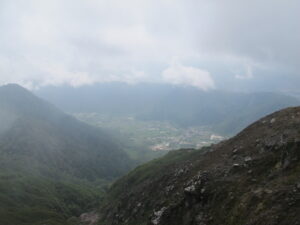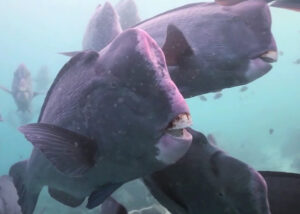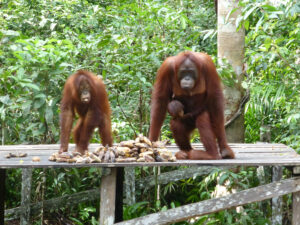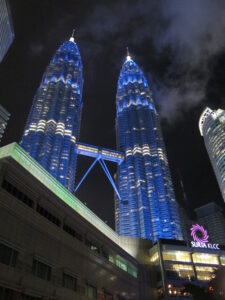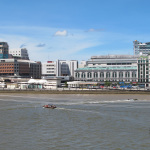
Unusual geopolitics in the early 60s led to the political division of Borneo island into three slices.
The biggest piece of the pie, southern Borneo, became part of Indonesia. A much narrower slice running along the northern coast became Malaysian, though the states of Sarawak and Sabah rest uneasily in their federation with the Malay peninsula.
And then there’s the chunk of the Malaysian portion, two disconnected bite-sized pieces reserved for the Sultanate of Negara Brunei Darussaslam. Just as Muslim tribes swept into northern India eight hundred years ago, others took hold of this area. And once borders, colonial empires and alliances finally settled in the 20th century, this largely Muslim country remained independent, like Monaco.
Brunei was fortunately located on somewhat of a peninsula, with a broad river leading to the sea and sheltering harbor. Ocean trade and fishing thrived , as did its occupants. And then the area proved to have one other big advantage: below ground, it was sopping with oil. That discovery and the ongoing flows of oil and gas since have made the Sultan – who owns anything in the ground below 10 meters – a very rich man. He reportedly shares the wealth with his people thru housing developments, free healthcare and education, grand mosques, excellent roadways, parks, good wages and no taxes.
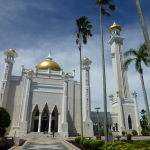
But you don’t see much display of wealth here. Driving into the capital from its western border, the houses seem plain, somewhat like military camps. That city, Bandar Seri Begawan, is a very small one, even with all the government buildings scattered about. The mosques are grand in scale, though suitably restrained in decoration – the main one downtown topped by a huge dome that is a mosaic of golden colored Venetian glass. Its brother a few kilometers away features a dome decked in gold foil. Water features and gardens add an earthly delight to their sacred purpose.
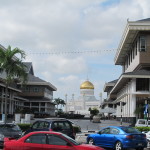
The shopping malls like the showcase one connecting the central mosque with the riverfront are drab affairs, and – more 1960s than 21st century – a shadow of the glamour and bright splendor found in the malls of Singapore and KL.
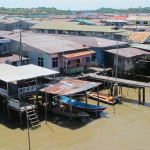
The most striking feature of Bandar Seri Begawan is Kampung Ayer, its extensive water village within Sungai Brunei River a few minutes powerboat ride by water jitney from the city’s dry land. According to Kampung Ayer’s tourist center, over 30,000 people live there in wooden houses on wooden piers. Like Venice, all are connected by walkways for short hops and boats for longer ones.
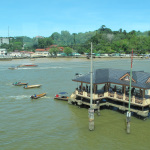
With it’s own mosques, clinics and schools, the self-contained community is, in effect, the central city for its residents. This style of urban living dates back at least a thousand years according to historical records, but is really just a larger version of the fishing villages on stilts you can see all over Indonesia.
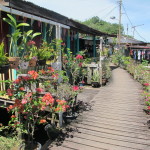
Most of the water village is not glamorous, with unpainted walls, though the communal buildings and new housing developments can be colorful and stylish. Many exteriors feature extensive planting, almost gardens up on the planks. The interiors of the homes range from basic to quite well furnished despite how they look on the outside. We visited one large home that was extensively carpeted, with overstuffed furniture and rich wall coverings. The “streets,” – whether wooden walkways or watery channels amidst the stilts – bustle throughout the day.
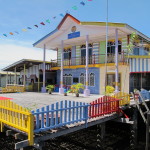
By contrast, tucked away in the suburban periphery of the city, fancier homes and even mansions nestle in the manicured communities. A bit farther out of town, you can stay and play at the Empire Hotel and Country Club, a sprawling luxury complex for the very well-heeled.
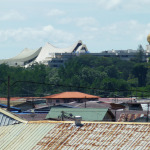
Meanwhile, just a few kilometers and a short bus ride from city center, you can still find native mangrove wetlands and the simian occupants of Monkey Island. As well as the Istana, or Palace. The Istana’s massive gold-tipped fencing surrounds a forested, well guarded parkland.
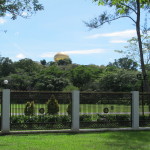
Nestled within, sprawling over 2 million square feet, with nearly 1800 rooms and over 250 bathrooms, is the largest residential palace in the world, bigger than the Vatican or the Louvre. It’s so big that a hotel management company is hired to keep it functioning. Yet only its gold domes are visible from outside the gate, except for a slightly more revealing view from a public sculpture garden nearby.
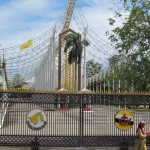
There you get a glimpse of pancake-like buildings topped by long arcing rooftops in traditional Malaysian-Indonesian style, The only better view possible happens on the three festival days annually that the Sultan opens the palace for visits by his people.
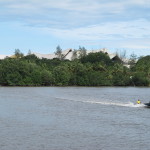
You can also peak into the lifestyle of the rich and powerful head of state at the Regalia museum in town. There, for free, citizens and foreigners can follow the Sultan’s personal history and learn about his good qualities, including his avid sportsmanship (polo, golf, badminton).
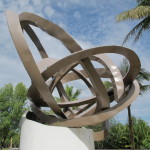
Otherwise, the museum is largely a storage area for gifts and tchotchkes given him by global leaders. Could he not find space in the 1800 rooms of the palace for the items filling room after room here? Or perhaps these are things he didn’t really want?
Other rooms wander off in different directions, if you have sufficient curiosity to continue. One large display is the Sultan’s Coronation throne from 1967, a gilded seat decked out with scimitars, swords, other emblems of power, two golden cats…and our favorite, the golden arm with cupped hand so the crowned leader can rest his head. Heavy sits the crown atop it?
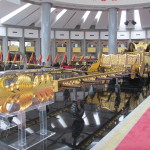
Dominating the museum otherwise are two massive chariots painted in gold trim, one for the coronation, and one for a ceremonial parade whose occasion we never could quite figure out That was displayed in a darkened 100 meter long hall, with dramatic accent lighting – where photos were forbidden. The sultan’s golden high chair sat behind elongated poles on wheels so the hundred of attendants, here displayed as mannequins in full costume, could pull the thing.
The curators tried to capture the whole scene by pasting on the walls photographs of buildings past which the procession actually moved. In front of these, and lining the walls, stand life-size photographs of Bruneians along the way, presumably enjoying the festive occasion.
The hundreds of faces, strangely, wore largely dour expressions, with maybe five smilers among them. They didn’t seem to be squinting in the sunlight. What were they all thinking? And what were the curators thinking by putting these joyless folks on display? Odder still, it seems that many at the procession knew they were being photographed, including a man in a wheelchair who stares threateningly at the photographer.
Back outside the museum, the locals seem happy enough. There were certainly plenty of smiles directed at us, even though otherwise Brunei is not very tourist friendly. It’s hard to get here, opening times are erratic, and there are no tourist offices except private tour operators. But the muted splendor flowing from oil riches and the extensive water community of this Bornean Venice made our visit very pleasant.
(Also, for more pictures from Malaysia, Singapore and Borneo, CLICK HERE to view the slideshow at the end of the Malaysia/Singapore itinerary page.)



